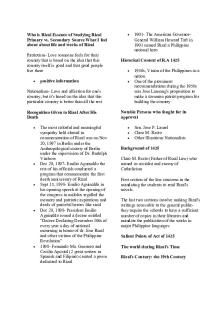Rizal Life and Works of Module 1 Lesson 1 5 PDF

| Title | Rizal Life and Works of Module 1 Lesson 1 5 |
|---|---|
| Author | Natalie Cher |
| Course | Rizal |
| Institution | Arellano University |
| Pages | 28 |
| File Size | 6.5 MB |
| File Type | |
| Total Downloads | 38 |
| Total Views | 176 |
Summary
This module contains lessons on Rizal's Life and Works and activities at the end of every lesson....
Description
Life and Works of
DR. JOSE RIZAL SOC SCI 4 S.Y. 2020-2021 DAVAO DEL SUR STATE COLLEGE (DSSC)
MODULE 1 Lesson 1-5
LESSON 1
Introduction to The Study of History
Learning outcomes At the end of this lesson, students shall be able to: • Define and know the scope of history; • Identify the sources and dimensions of history in general; and • Discuss the concept of historical documentation and historical imagination Welcome to the “New Normal” form in teaching and learning process. In this lesson, you will be introduced to the scope of history, its sources, historical documentation, methodology, various dimensions, and its relevance. This will only take up few minutes of your time. Hereafter is an activity that will tickle your mind about you and your role in history. ACTIVITY Instruction: Select at least 2 items from the list that can be found inside your house (the oldest issue) and take a selfie with it. Kindly attach the photos of the chosen item in a separate page. 1. 2. 3. 4.
Old Clock Old Coin or paper money Old jewelry Letter since 5-10 years ago 5. Old calendar ANALYSIS • Provide some of your thoughts on History and of it as branch of social science. • Enumerate the two sources of History. • Explicate each of the following: Historical Documentation, Methodology, Imagination, Dimensions, and Relevance. ABSTRACTION Meaning and Scope of History The word history comes from the Latin word, “historia” which means an “inquiry” or “investigation”. Historians tend to study history based on the past where they are looking for the evidence of an event or even civilization. The study of history became one of the oldest disciplines in liberal arts. History is defined as “the branch of social science which deals with the study of the past in relation to the present and the future”. Based on this definition, there are 3 important elements of history: a.) as branch of social science, b.) study of the past, c.) relation to the present and future. It is very important to examine the 3, as stated. 1. Branch of Social Science – Science is defined as “the study of facts based on observation and experimentation”. Sciences are divided into 3: physical, natural and social sciences. Our main concern is on social sciences where history belongs. 2. Study of the past – peoples, event, places and even civilizations are one of the main concerns in the studying history. Therefore, we will study the past, regarding Rizal’s Life, works and writings that all happened in the 19th century Philippines.
3. Relation to the present and the future – History is the study of the past in relation to the present and the future. For instance, even if Rizal belonged to the 19th century, his life, works and even his thoughts are relevant until today. His first novel, Noli Me Tangere talks about the “social cancer” like corruption, vices, and wrong beliefs that are still existing up to this time. Sources of History: 1. Primary Sources – these are the physical evidence in history such as artifacts, relics, remains, fossils and even oral tradition. 2. Secondary Sources: a.) Published Materials – such as newspapers, magazines, journals, encyclopedia, pamphlets, handouts, books, circulars and other materials which are published either in hard and soft copies; b.) Unpublished materials – such as letters, biographies, autobiography, theses and dissertations and other papers written by a scholar. Historical Documentation According to Teodoro Agoncillo (the late nationalist historian), “no documents, no history…” which had given the “documentary evidences” more weight rather than “sabi -sabi” or hearsays. Historical documentation is very important for biography in the sense that the person was existing during his time. Records like letters, birth and death certificates, voice recordings, paintings and even court records show the “primary evidence” in writing history. Historical Methodology The process of writing historical details is called “historiography.” It narrates history in a proper way according to the time, space and depth. Writing history depends on the scope of the writer’s research and his critical analysis in using the available sources and references. What is “historical imagination”? The concept of historical imagination is when the reader puts himself in the picture or writing history using one’s imagination. For example, reading biographies puts you in the same person in order for that person to come alive. Using historical imagination is also a part of learning history in which “internal and external criticism” should be applied. Furthermore, by employing historical imagination, we make the story come alive. Dimensions of History 1. Place/Geographical Dimension – the location of event(s) is really important. For example, in the battle of Waterloo which Napoleon fought against the Perussian, he missed to consider the climate of the country which was winter. Most likely, the climate was the biggest factor why he lost the historic, Napoleonic War. 2. Time/Chronological Dimension – in history, time element is very important. It is the barometer of historical events. Dating might be considered as a great factor to distinguish time such as the period when Rizal was born. Generally speaking, in history, there are 3 important datings: Ancient, Medieval and the Modern Period. The Ancient Period is described as the geological time scale up to man’s existence and its civilization. The Medieval Period or Age of Faith was when man learned how to value faith and education. The Modern Period is described as the period when man discovered and learned the essence of technology as well as to harmonize his works with environment. Relevance in Studying History The study of history has a great significance and relevance to the modern era since this is the foundation of the nation’s national identity. The study of Philippine History gives more emphasis in how Filipinos fought
during those times of struggles such as the Propaganda Movement (1892 – 1896) which influenced by several “paisanos” in Europe (Rizal, Del Pilar and Lopez – Jaena). APPLICATION Trace the history where Rizal experience quarantine in an epidemic or pandemic.
CONGRATULATIONS! You finished the lesson 1! I hope you enjoyed and learned in this lesson. Kindly proceed to Lesson 2.
LESSON 2
Rizal Law and Rizal’s Early Biographers
Learning outcomes At the end of the lesson, the students shall be able to: • Discuss the concept of historical documentation and historical imagination; • Identify the issues on Rizal Law which can be a dissertational course for the students who are not aware of the relevance of the course in relation to their field of expertise; • Expand the relevance of the law in the nation building of a true Filipino; • Identify “who’s who” in Rizal’s life especially in his biography; • Discuss how the writing of history can change the image of the country; and • Explain the relevance of the course in general to the daily life of the Filipinos nowadays. Welcome to the 2nd lesson of this module! In this lesson, you will be introduced to the Rizal law and its analysis, the K-12 law, biography and autobiography, and writing historical accounts. This will only take up few minutes of your time. Hereafter is an activity that will tickle your mind about you and your role in history. ACTIVITY Instruction: Make a “blog” or account regarding the history of life in the 19th century. You will start with the description of those times from political, economic and social events. Make a report regarding this activity. ANALYSIS • Provide your ideas about the congruence of Rizal Law and K-12 Law. • Explain the importance of biography and autobiography. ABSTRACTION The Rizal Law (R.A No. 1425) One of the important legislation to boost Filipino nationalism is the Rizal Law or Republic Act No. 1425 which highlights the following: 1. The study of Rizal’s Life, Works and Writings can support and foster the cause of nationalism for Filipinos especially the youths; 2. The inclusion of the works of Rizal in the College Curriculum particularly the study of his novelsNoli Me Tangere and El Filibusterismo are necessary to have a better understanding of 19th century Philippines; 3. The inclusion also of other works of Rizal such as his letters, paintings, travels can promote the cause of nationalism; 4. Funding of the law in order to give supplemental copies of the novels to public libraries; and 5. The implementation of the law. Although this law is not declaring that Rizal is a national hero, it can be a positive step towards enshrining him and other national heroes of the country. Analysis on Rizal Law Students often wonder why they have to study Rizal course. What is its relevance to their course or their field of expertise? There are several answers to this question:
1. The adoption and implementation of R.A No. 1425 which clearly states that the study of Jose Rizal’s Life Works and Writings must be taught in all public and private Schools, Colleges and Universities; 2. The study of Rizal’s work particularly his two important novels- Noli Me Tangere and El Filibusterismo and other works (poems, diaries, essays) as well as their translations in Filipino and English should be implemented and funded by the government as provided for in the law; 3. The law also mandates the study of Rizal’s life, works and writings in the secondary levels specifically the Noli Me Tangere on the 3rd year level and El Filibusterismo in 4th year level. This forms part of the Filipino curriculum where the medium of instruction is Filipino; 4. The Rizal course offers a wide range of thoughts on how Rizal and other heroes (Marcelo H. Del Pilar, Andres Bonifacio and Apolinario Mabini and others) fought for freedom for the sake of the country’s survival against the “evil emperialism” of foreign invaders. Rizal Law and the K-12 Law The study of Rizal is still part of the K-12 Law and the new General Education Curriculum in the sense that Rizal course is mandatory to college students with a view to develop their historical thinking and national awareness. The study of Rizal may also give reflections on the events of the past that formed part of the Philippine History and to awaken the minds of the modern Filipinos who are popularly called “millennials”. Biography and Autobiography The words “biography” and “autobiography” are sometimes used by readers interchangeably. When somebody writes your life from challenges to triumphs that is called, biography. Therefore, the writings on Rizal’s life are divided into two-those that were written by others and those that were penned by Rizal himself. The biographies of Rizal are one of the main secondary sources of Rizalian History, Rizal’s autobiography was written on his “epistolario Rizalinos” which was compiled by Teodoro Kalaw. Writing Historical Accounts Writing historical accounts is considered as one of the prime tasks of a historian. The coined word is PEP for people, event, places which means that the story must have these three important components. In Rizal’s biography for example, the people (noted personalities) became the characters of his novel, Noli Me Tangere. The events that took place at that time as well as the 1872 mutiny became one of the root causes of Rizal’s nationalism which led him to write his second novel, El Filibusterismo. He dedicated El Fili to Gomburza, the martyrs of Filipino secularization. Rizal also noted in his travels the notable places that he clearly and poetically described. Early Biographers of Dr. Jose Rizal There are several biographers who attempted to write the life and works of Jose Rizal; several of them considered as authentic as well as very fluent in terms of historical details and analysis. Though there are several textbook writers who wrote the life history of Rizal, below are prominent writers who wrote about the life of the great Filipino national hero. Account of Wenceslao Retana Wenceslao Retana is known to be one of Rizal’s contemporaries who was critical of Rizal’s nationalistic fervor. Retana, in the newspaper “La Epoca”, attacked Rizal and the latter challenged Retana to a fist fight. On the other hand, Retana apologized to Rizal and the two became friends. Retana admired Rizal for being a gentleman. In the eyes of Retana then, Spain was “wrong” when they executed Rizal (Medina, 1998). Retana believed that Rizal’s execution was proof of the injustices committed by Spain towards Filipinos. That fateful event led to the 1896 Philippine revolution. The writer, Medina states why Retana’s accounts about Rizal must be read: “In my opinion, what makes Retana most deserving of being read today is as a creditable witness of the historical moment that has had the greatest impact on the Filipino consciousness, and how Rizal transformed himself into its symbol. He gives witness as one who embodied and was able to clearly state the meanings that the mentality of those
times ascribed to those events. Thus, I believe, he is able to transmit to Filipinos a hundred years hence a vision that is both moving and explicative in a culturally accurate mannerhe succeeds in transporting us to that compelling time, so that we may gain insights that a conventional academic approach cannot give. Given the distancing that our North American colonization produced in the Filipinol psyche vis a vis the mythical figure of Rizal and the legendary time he lived and died in, the Retana biography’s availability today, translated and explained with cultural sensitivity, after the long forgetting of both work and its creator’s fascinating figure, is an important cultural event during our Centennial year.” Therefore, observation at par really helped wherein Retana’s personality became one of the main figures in Philippine history. Account of Carlos Quirino One of the great biographers of Dr. Jose Rizal wrote Rizal’s biography because of a “writing contest”. He answered to the invitation to several writers at that time to write about Rizal’s life. The work of Carlos Quirino entitled, “The Great Malayan” won the 3rd prize. However, President Manuel Quezon awarded the monetary reward which was equivalent to the 1st prize of the contest. It was one of the classical best in Rizal’s biography- in pocketbook size. Based on that work, Quirino described Rizal as an “ordinary person” with a great love for his country, his compatriots and for the search of truth. His analysis of Rizal then was the “product of his times”. Account of Rafael Palma One of the important biographers of Rizal was Rafael Palma. His work, Biografia de Rizal (Biography of Rizal) was one of the greatest and finest biographies of the national hero. Compared with Quirino’s writing, Palma’s writing can be considered as the primary source in history as it is more serious and academic. Account of Austin Coates Austin Coates (1922-1997) is known for his detailed work on Rizal’s biography entitled, Rizal, Philippine Nationalist and Martyr which was published in 1968 by Oxford University Press. Though it is lacking in academic standards, Coates discussed Jose Rizal as one of the greatest patriot ever generated in his times which is no other than 19th century. Also, he wrote Rizal’s biography from the eyes of a foreigner whose details and authenticity cannot be found in the local college textbooks. Account of Leon Maria Guerrero One of the most readable biographies of Rizal was the work of Leon Ma. Guerrero which is entitled, The First Filipino. Leon Ma. Guerrero (1853-1935) was one of the popular writers of Rizal’s biography. In his introductory statements, he described the 2 types of Spain; one was great and the other was evil. The evil side of Spain was where Rizal moulded his nationalism. Guerrero also described other events of the 19th century that may not be appreciated by the individual who does not know or has not read the history of Spain in the Philippines. Furthermore, his book is one of the best source and rich in Rizaliana historiography, one of the finest after Palma’s work. Account of Ambeth Ocampo One of the modern historians is no other than Ambeth Ocampo who discussed history in a “telling to a friend” approach. His journalistic pattern of writing earned him the title of the best modern historian in our time. His work on Rizal’s biography is entitled, “Rizal Without an Overcoat”. With the same style of Quirino’s writings, he makes or even remakes Rizal as an ordinary Filipino. He exposed Rizal as person with big ambitions for his countrymen. He believed that education was the best weapon to expel the evil Spanish tyranny. Ambeth Ocampo,being one of the contemporary historians shares his thoughts regarding the most “updated” details in history-from the physical evidences to historical analyses, being trained as a scholar. Reading Ambeth’s works as well as listening to his several lectures in Ateneo and Ayala Museum can be a great historical experience.
APPLICATION 1. Why should we study the Life and Works of Rizal? Expand the relevance of the law in the nation building of a true Filipino. Explain the relevance of the course in general to the daily life of the Filipinos nowadays 2. Choose one biographer that could discuss the life of Rizal and how his/her writing of history can change the image of the country.
CONGRATULATIONS! You finished the lesson 2! I hope you enjoyed and learned in this lesson. Kindly proceed to Lesson 3.
LESSON 3
The Philippines in the 19th Century
Learning outcomes At the end of the lesson, the students shall be able to: • Describe what was the political, economic and social life of the Philippines during the 19th century; • Discuss why Rizal was the product of his times; • What were the institutions being imposed by Spain in the Philippines during the 19 th century; • Elaborate on the life of the Filipinos during that time; and • Give the importance and relevance of how nationalism was molded in the heart and mind of our national hero. Welcome to the third lesson of this module! You will be scholarly introduced on the situation of the World in the 19th Century, how the Philippines is doing during the 19th century, and the qualities on why Jose Rizal was considered as a cardinal product of his time. Hereafter is an activity that will help you discover Dr. Jose Rizal’s qualities, and how these qualities correlate to yours. To appreciate and understand the life of Dr. Jose Rizal, it necessary to know the historical background of the world and of the Philippines during his times. The 19th century when he lived was a century of ferment caused by the blowing winds of history. In Asia, Europe, and the Americas, events surged inexorably like sea tides, significantly affecting the lives and fortunes of mankind ACTIVITY Make a tabulation of the qualities of Rizal into: Divine Intervention, Family Orientation, Environmental Factor and Education. Describe also your own personality using the same tabulation. ANALYSIS • Describe the situation of the World during the 19th Century. • Describe the situation of the Philippines During the 19th Century. • Why do Filipinos consider Rizal as a product of his time? ABSTRACTION The World during the 19th Century The 19th century is known to be the Age of Enlighten in Philippine history which can be described as a colorful part of our history. There were several events that took shape that had impact in the Philippine soil. Among these were the ff.: a.) United States of America - according to the diary of Rizal was too impressive in the sense of their rapid industrialization that time and Rizal commented that America will be the next superpower after Spain. The racial issue hampered its racial discrimination in the mainland as described in the book, Uncle Tom’s Cabin written by
Harriet Beecher Stowe where negroes are subject to slavery by the “whites”. When President Lincoln became the president, several reforms took pace such as the “emancipation of slaves” in response to the racial issue and enfranchising them as well as awarding them either American citizenship. When Rizal was born on June 19, 1861, the American Civil War (1861-65) was raging furiously in the US over the i...
Similar Free PDFs

MODULE 7 LIFE AND WORKS OF RIZAL
- 9 Pages

Module in LIFE AND Works OF Rizal
- 97 Pages

Life and Works of Rizal
- 57 Pages

Life and Works of Rizal
- 16 Pages
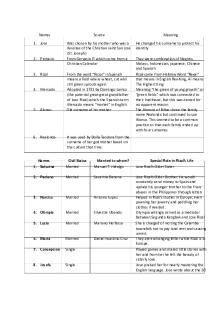
Life and works of rizal
- 3 Pages
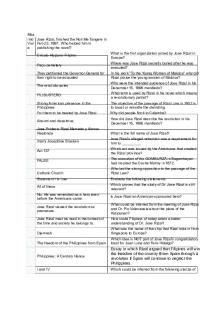
Life works of rizal
- 12 Pages

Rizal life and works
- 15 Pages
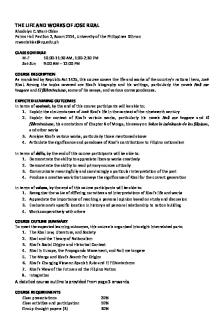
Syllabus Rizal Life and Works
- 13 Pages
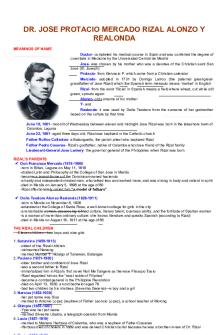
Jose Rizal Life and Works
- 35 Pages

LWRN01G Life-and-Works-of-Rizal
- 156 Pages
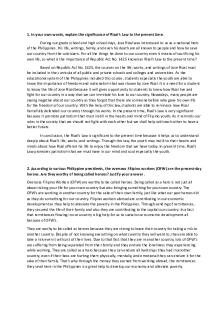
Life and works of Jose Rizal
- 2 Pages

LIFE-AND- Works-OF- Rizal- Summary
- 73 Pages
Popular Institutions
- Tinajero National High School - Annex
- Politeknik Caltex Riau
- Yokohama City University
- SGT University
- University of Al-Qadisiyah
- Divine Word College of Vigan
- Techniek College Rotterdam
- Universidade de Santiago
- Universiti Teknologi MARA Cawangan Johor Kampus Pasir Gudang
- Poltekkes Kemenkes Yogyakarta
- Baguio City National High School
- Colegio san marcos
- preparatoria uno
- Centro de Bachillerato Tecnológico Industrial y de Servicios No. 107
- Dalian Maritime University
- Quang Trung Secondary School
- Colegio Tecnológico en Informática
- Corporación Regional de Educación Superior
- Grupo CEDVA
- Dar Al Uloom University
- Centro de Estudios Preuniversitarios de la Universidad Nacional de Ingeniería
- 上智大学
- Aakash International School, Nuna Majara
- San Felipe Neri Catholic School
- Kang Chiao International School - New Taipei City
- Misamis Occidental National High School
- Institución Educativa Escuela Normal Juan Ladrilleros
- Kolehiyo ng Pantukan
- Batanes State College
- Instituto Continental
- Sekolah Menengah Kejuruan Kesehatan Kaltara (Tarakan)
- Colegio de La Inmaculada Concepcion - Cebu

